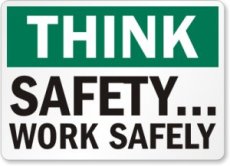
Workplace health and safety always needs to be a current topic of conversation if you are going to keep up to date with safety legislation and develop a smart strategy for protecting the workforce.
Some of the most commonly reported incidents in the workplace are eye injuries and when you consider how vital your vision is, doing what you can to stay safe should be a priority.
Here are some tips and insights on eye safety. There is an overview of the potential hazards plus a look at what you should do if you wear contact lenses, and details of which type of protection is suited to the work you are doing.
Most eye injuries are avoidable
It is generally estimated that about 90% of reported eye injuries in the workplace could be avoided if the right protective eyewear had been worn and safety procedures followed.
Not enough workers are wearing protective eyewear and when you consider that somewhere in the region of about 40% of eye injuries are caused by what could be viewed as fairly mundane and not exactly dangerous activities, it seems the dangers aren’t always fully appreciated.
If you want to protect your eyes from injury it is important to understand the potential dangers that you might be facing at work. Carry out a risk assessment to identify hazards and eliminate the risk of injury as much as possible by using machine guards and screens as well as using proper eye protection.
Safety issues surrounding contact lenses
There are plenty of people who wear contact lenses rather than glasses so it is a relevant question to ask whether they can be worn safely in an industrial environment.
The most poignant point to bear in mind is that contact lenses are not designed to provide any significant level of protection from eye hazards in the workplace, but it should also be noted that there is no real evidence to support the suggestion that anyone wearing contact lenses is facing any increased level of risk either.
It might actually be argued that because contact lenses are able to deliver improved vision to the wearer, it could even help their safety profile, but only if they are also wearing the appropriate safety goggles as well.
Goggles or shields?
Safety glasses provide eye protection across a range of different working conditions and they are designed to protect your eyes from dust and flying particles amongst other things.
Safety goggles also provide that same level of protection but they also provide a secure shield around your entire eye, so that any hazard coming from any direction should be prevented from hitting your eye.
You can wear safety goggles over prescription glasses as well as contact lenses, so everyone should be able to find the protective eyewear they need.
You might also want to consider a face shield if you are likely to be exposed to chemicals. The shield would be worn in addition to safety goggles or glasses so that you are still protected when you lift the shield up at any time.
If you are committed to protecting your eyes at all times, it makes sense to know your options when it comes to safety eyewear.
Matthew Goodwin is an industrial safety officer. He is writing articles to raise awareness of safety at work, both for employees and employers. For safety goggles and eye shields take a look at RS-Online.com for a wide range.






